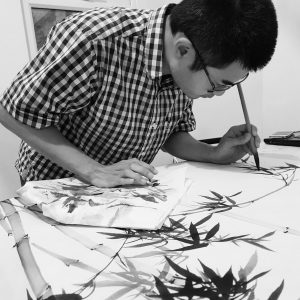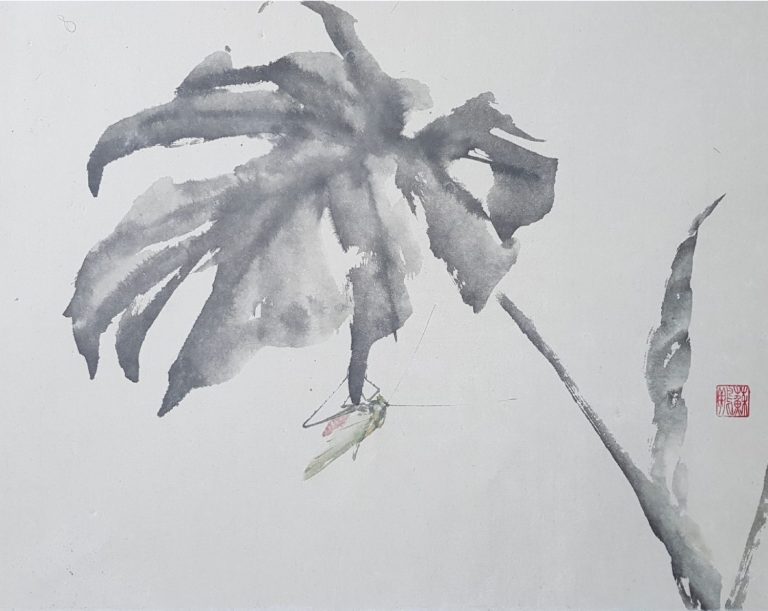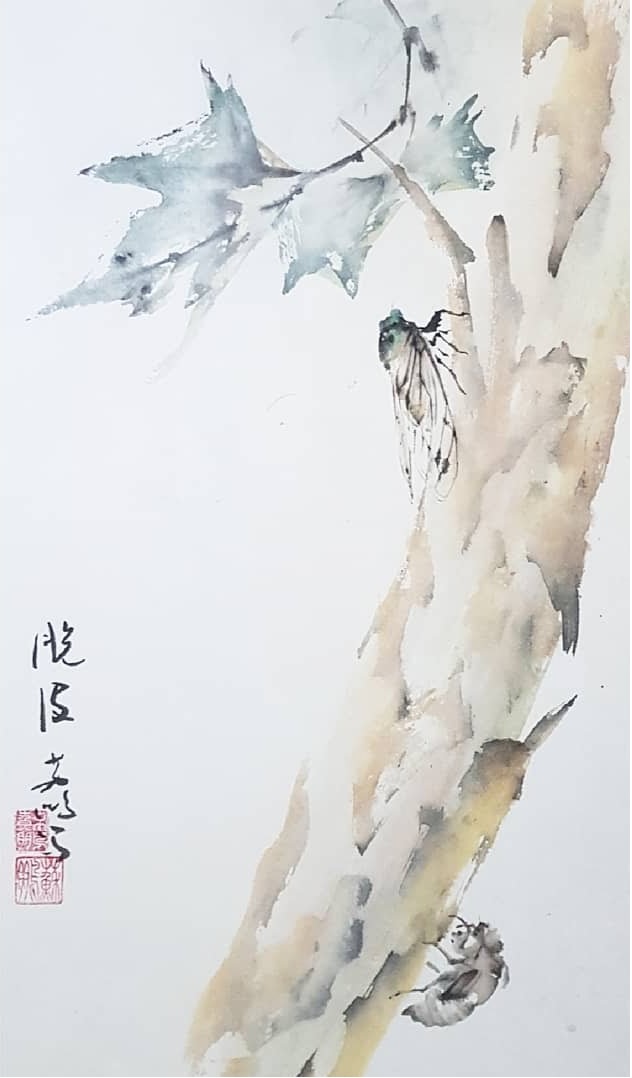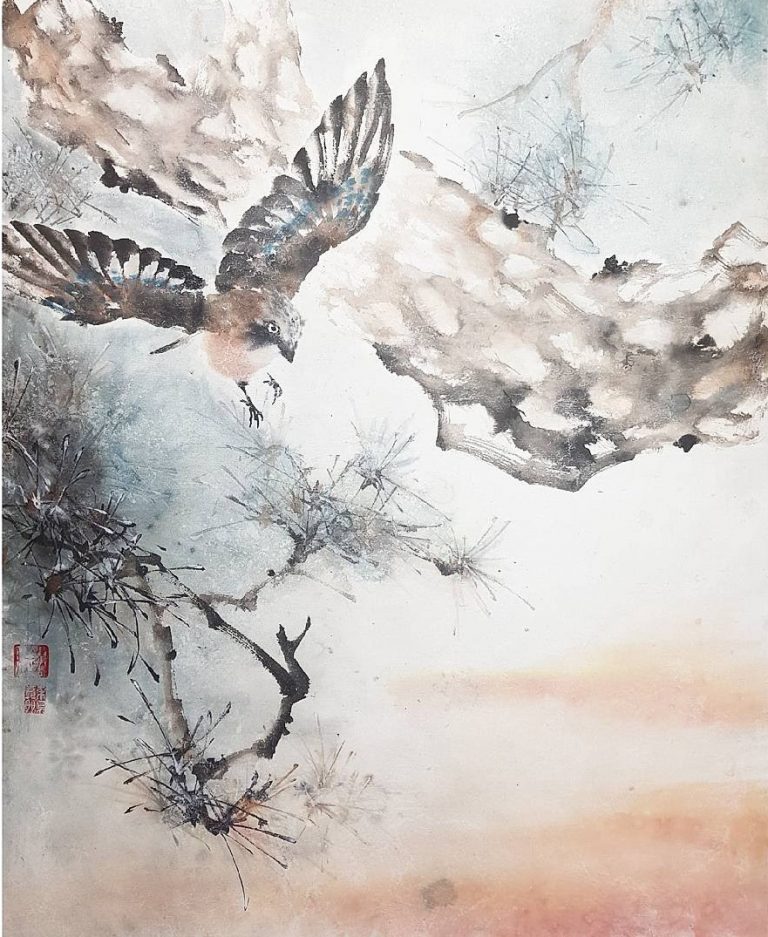I'm Peng Su 鹏苏, originally from North China and taught by my great-grandpa Baozhang. I now live in the UK -- painting exhibiting and tutoring in Chinese watercolour and Japanese Sumi-e painting.
About me
As a child I practised traditional Chinese painting with my great-grandpa Baozhang, a local photographer and artist. His favoured technique was elaborate gongbi, and I would watch as he painted layer after layer over several weeks, gradually building up a delicate loving image.
Baozhang peacefully passed away at the age of 94, when I was nine, and I began to pursue my love of nature through drawing and education. I eventually moved to the UK to study Geology and Biology, before my passion for art truly took hold again. I wished to show the true beauty in nature; backwards facing flowers, old broken stems, and crusty browning leaves. I hope I can honour my great-grandpa's kindness and passion for the beauty in the world around him.
My style is developed from traditional xieyi; a freehand form of Chinese painting in which the emphasis is on the brush strokes and feeling, rather than the details. I'm inspired by the Lingnan school in particular, who's founders travelled to Japan and experienced the meiji ishin (Japanese Renaissance era). In that time western art was not accessible to Chinese artists, and instead, they were influenced by Japan's adaptation of western elements such as light, proportion, use of backgrounds, and sense of depth. The Lingnan school also emphasises the use of colour, revolutionary when only ink was available or accessible in traditional Chinese art.
After moving to the UK, I was inspired by western watercolour paintings which ranged from impressionist to realistic. I loved the sense of storytelling and atmosphere. Whereas traditional Chinese work may only paint a bird, for example, Western art seemed to use background details and washes to bring the eye towards the bird -- Also bringing the feeling of time, place, and season. I felt such techniques were worth adapting in to traditional Asian work, in conjunction with Japanese sumi-e.
The beauty of sumi-e style is making the most of the water on the brush, and the bleeding of ink on the rice paper. Such effects are not possible with dry western watercolour paper, and allow for the construction of images from only a few well planned and practised strokes. My work aims to bring together western watercolour details, with these simple bold strokes in which I contort, dampen, multi-load, skip, and twist bamboo brushes across delicate rice paper. My focus is on composition, the feeling of season and time, and the stories in nature.
In particular, I enjoy painting small animals; birds, insects, and fish. I like to paint animals and plants that I've studied, grown, or raised in the person -- I think that's how you can truly bring life into your work. Rather than appearing as specimens, I can absorb how they move or react, so the real moment can be captured. I have a love of flight, growing up caring for birds and making inflatable kites, continuously redesigning and tweaking based on my observations in the wind rather than mathematical calculations. My work often highlights the influence of wind, whether it's the bending growth of plants, twists of fluttering leaves, or birds struggling against or floating with it.
I hope you can feel the spirit of this beautiful world through my paintings. Both the nature it represents, and the cross-cultural artistic styles it employs.
Classes
I run a range of workshops and offer private tutoring in several forms of Asian art throughout the UK. I also offer Skype lessons for those abroad, residentials for experienced students, and am available for live painting at events.
Chinese Xieyi: Xieyi or 写意 literally means 'sketching thoughts', and is a freestyle technique from the Song dynasty. It focuses on the flow of the brushstrokes and sophisticated composition. Subjects range from flower and birds to misty mountain landscapes and employ both black ink and colour.
Japanese Sumi-e: Simple powerful black ink strokes, practised with meditative-like repetition, to produce beautiful images of nature. Beginners typically enjoy bamboo and blossom, with more advanced painters exploring fish and birds.
Chinese Gongbi: Elaborate Chinese style paintings with outlines and colour. An ancient art form from the Han dynasty over 2000 years ago. This requires very fine brush strokes with great precision and appreciation of natures details. Highly time-consuming, one simple painting can take up to two weeks and requires a patient artist!
Chinese Art History: Introduction to the different forms of Chinese art from the early Gongbi style which evolved into ink-based Xieyi before colour inks became more available. Includes discussion of the influence of Japanese art, which made it's way to China through the Lingnan school and resulted in an art form including both the traditional elements and strokes, and the previously foreign aspects of light and perspective.




